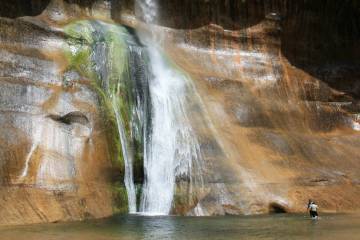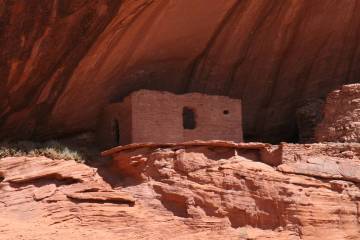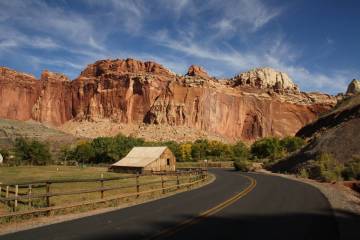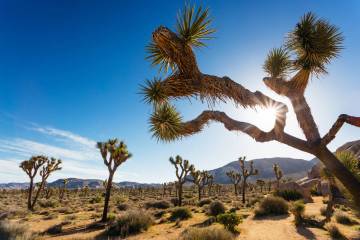Virgin River hike a must this time of year
The Zion Narrows attracts hikers and adventurers from many parts of the world, but Southern Nevadans are fortunate enough to live within a few hours of this marvelous and unusual hike. If you haven't yet experienced it, or want to repeat it, the next month or so should offer ideal conditions. The hike involves a good deal of wading the Virgin River, so danger of flash flooding is its greatest drawback, but monsoonal weather is hopefully over for the year, and the temperatures of both air and water should be perfect.
The Narrows is a tight, high-walled canyon carved by the North Fork of the Virgin River in Zion National Park, Utah. The river serves as your trail. In low-water times, it is literally a walk in the park, but when water flow is high, it will test your physical and mental skills. At such times, it can be the hardest hike you have ever done. During extreme flows, you should not enter the Narrows even for a short hike.
Furthermore, the water can be very cold, and the slippery rocks can easily bring anyone down at a moment's notice. But most feel the rewards are worth it. In some areas, the left and right canyon walls are only 20 feet apart, yet dramatically tower more than 1,000 feet over the hiker's head. As you travel the Narrows, you will find cascading waterfalls, hanging gardens of ferns and wildflowers and hidden alcoves, all a feast for the eyes. Sunlight and shadow dance constantly over the water, as the hiker's viewpoint changes with his or her movement. The very rock cliffs work to entertain you, varying from tan to orange to blood red.
There are at least three ways to hike the Narrows: an out-and-back hike from the lower end; a single-day through hike from the upper end; or an overnight hike from the upper end, camping in the canyon. You will need to acquire a permit for the last two. If it's your first adventure here, I would recommend the first and simplest option: dropping into the river from the Riverside Walk, heading upstream as far as you feel comfortable, and returning. On days with a low water flow, those with sufficient stamina can hike as far as Big Springs — about 8 miles round-trip and the farthest the park service allows without a permit.
For such a round-trip day hike from the bottom up, take the free shuttle from the Zion Visitor Center up Zion Canyon to the last stop, at the Temple of Sinawava. From there, walk up the paved Riverside Walk Trail about 1 mile and then drop into the waters of the Virgin River at the obvious trailhead.
The hike consists of dozens, if not hundreds, of river crossings, in order to avoid boulders and deep pools of water as you make your way. For ease in hiking, you can rent great water shoes, or even a dry suit, from one of the outfitting companies in Springdale. You can also rent a wooden staff to use as a third leg — and you will definitely need one. Don't think a regular commercial hiking/trekking pole will work; most don't. If you have everything but a wooden staff, just head to a home improvement store and buy a large wooden dowel. The best size for most adults is about 1 ¼- to 1½-inch thick, and about 5 feet long, depending on your height.
The river's water volume is measured in CFS (cubic feet per second). When it flows at a rate of 120 CFS or higher, back country permits are not issued for through hikes, and when the flow is more than 150 CFS, no hiking at all is allowed in the narrows. The very best hiking conditions are when the water flows less than 70 CFS.
Even if the skies are clear, when in Zion, be aware that thunderstorms miles up some tributary can send water pouring into the Narrows, causing much more adventure than you were seeking. Therefore, even on the most beautiful of days, always get a weather report and water flow rate from the Wilderness Desk at the Zion Visitor Center before setting out. It is open this time of year from 7 a.m. to 6 p.m. Also, wear warm synthetic clothing such as fleece — no cotton, for it loses its insulating qualities when wet, as it probably will be. Either line your pack with a heavy-duty garbage bag or put your gear in a dry bag. Carry your own drinking water or treat the Virgin River water before drinking.
— Deborah Wall is the author of "Great Hikes, A Cerca Country Guide" and "Base Camp Las Vegas: Hiking the Southwestern States," published by Stephens Press. She can be reached at deborabus@aol.com.
Directions
From Las Vegas, take Interstate 15 north 125 miles to Utah state Route 9 (Exit 16-Hurricane/Zion National Park). Follow Route 9 east for 19 miles to Springdale, Utah, and Zion National Park. From the Visitor Center, take the free shuttle to the Temple of Siniwava shuttle stop, the last stop in Zion Canyon.







